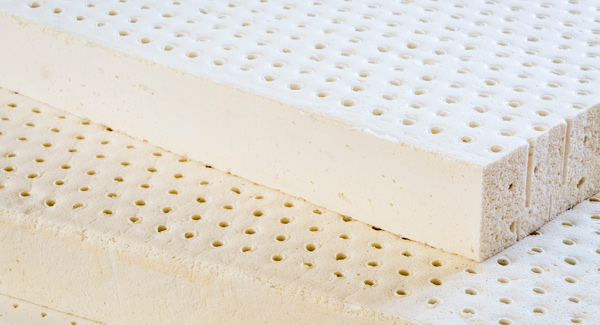Home » Mattress types » How Long Does A Latex Mattress Last?
How long does a latex mattress last?
Article navigation
- Published:
- Written by: Tony Brown
- Topic: Mattress types
Latex is a premium material that conforms well to body shape, offering excellent support and pressure relief. Natural latex comes from the sap of the rubber tree and is known for its durability and resiliency. A good-quality latex mattress can last between 15 and 25 years, provided it’s well-maintained.
However, not all latex mattresses are made equal. While some are long-lasting, others may wear out sooner than expected.
What factors influence the lifespan of a latex mattress?
The typical lifespan of a latex mattress depends on various factors, such as its construction, material quality and quantity, usage and maintenance.
Material quality and quantity
The quality and quantity of latex used in a mattress can vary. Some mattresses are made entirely of latex, while others may combine latex foam with other materials, such as polyester, wool, memory foam, or springs.
Determining the amount of latex in a mattress can be challenging. While you can often establish the materials inside the mattress based on the manufacturer’s specifications, you might not know the quantity. The mattress might only contain small amounts of latex, not enough to make a notable difference.
There are also different qualities of latex. Natural latex is incredibly resilient and durable and typically outlasts other mattress types. It offers a soft yet supportive feel, enabling the body to conform to the sleeping surface without sinking excessively.
Unlike traditional mattresses, which are prone to developing indentations, latex has excellent recovery properties. The material’s ability to quickly return to its original shape when pressure is removed helps maintain a consistent sleeping surface.
Synthetic latex, however, is entirely man-made from chemical compounds. It offers a cost-effective alternative to natural latex and is often used in cheaper mattresses. Synthetic latex is less durable than natural latex and breaks down much sooner. The typical lifespan of a mattress containing synthetic latex is between 7 and 10 years.
Some mattresses contain blended latex, a combination of natural and synthetic latex. While not as long-lasting as mattresses made entirely of natural latex, they offer a more affordable option.
Usage
How a latex mattress is used can significantly impact its longevity. Mattresses that are used regularly tend to wear out sooner than those used less often, for example, in a guest bedroom.
An individual’s body weight and size can also affect how long a latex mattress lasts. For example, heavier individuals apply more pressure on the mattress, causing it to wear out more quickly. Furthermore, a mattress used by two people is likely to wear out quicker than a mattress used by a single person.
Sleeping regularly in the same position may put more pressure on specific areas of the mattress. For example, side sleepers may notice indentations and body impressions in the areas where most of the body weight is concentrated, such as the shoulders and hips.
Construction
Two manufacturing methods turn liquid latex into foam – Dunlop and Talalay. With the Dunlop method, liquid latex is whipped into a frothy foam, poured into a mould, and then baked to harden, resulting in a firm and dense latex foam.
With the Talalay process, liquid latex is whipped into a frothy foam, partially filled into a mould, and then vacuum-sealed. This allows the latex to expand, creating a softer and more conforming feel.
Dunlop latex, being denser, is considered more durable than Talalay latex.
Care and maintenance
Regularly maintaining and looking after your mattress can help extend its lifespan. This includes turning the mattress where necessary to even out the wear, using a mattress cover to protect the mattress from stains and spillages and following the manufacturer’s recommendations.
However, sitting on the edge of the mattress for prolonged periods, allowing children to jump up and down on the bed or placing the mattress on an old, worn-out bed base will result in a much shorter lifespan and invalidate the mattress warranty.
How do latex mattresses compare to other mattresses?
Latex mattresses typically last longer than other mattress types. For instance, sprung mattresses usually last around 8 to 10 years, although higher-quality models with natural fillings may last longer.
Similarly, memory foam mattresses, constructed with different foam layers, also last around 8 to 10 years. However, a drawback of memory foam mattresses is their single-sided construction, which means they cannot be flipped. As a result, once the material starts to break down, the mattress will need replacing.
How to extend the life of a latex mattress
By taking proper care of your latex mattress, you can keep it in good condition, extend its life, and ensure it remains comfortable and supportive. Here are some practical tips to get the most out of your mattress.
Use a compatible bed base
Placing a latex mattress on a compatible bed base can improve comfort and protect the mattress warranty. Latex mattresses typically perform better on platform tops or slats. The base should provide a flat and even surface, supporting the weight of the mattress.
When using a latex mattress on a slatted base, ensure the spacing between the slats does not exceed the manufacturers’ recommendations. Always place a latex mattress on a well-ventilated bed base that allows good air circulation to prevent moisture build-up.
Avoid placing a latex mattress on an old, worn-out bed base, as this can damage the mattress and invalidate its warranty.
Use a mattress protector
A mattress cover protects your mattress from stains, spillages and accidents. It fits on top of the mattress and is typically held in place with elasticated corner straps or an elasticated skirt that stretch over the corners of the mattress.
A good quality mattress protector prevents liquids from penetrating the mattress and staining, discolouring or soaking into the material.
However, since latex closely conforms to the body, avoid using an overly thick protector. This can create an additional barrier between you and the material, affecting how the mattress feels and performs.
Rotate the mattress
Although latex is a resilient material that returns to its original shape when pressure is removed, occasionally turning your mattress can help even out the wear.
Most latex mattresses are single-sided and only require rotating end-to-end when needed. Some latex mattresses are double-sided. While flipping may not be necessary, it can help even out wear across both sides of the mattress.
Follow the manufacturer’s care instructions
Following the manufacturer’s care instructions will help ensure the mattress remains in good condition and prolongs its life. These instructions typically include guidance on rotation, cleaning, and precautions to prevent damage, such as avoiding using hot water bottles or electric blankets.
When to replace a latex mattress
Although latex mattresses are known for their durability, they will eventually wear out and need replacing. If you’re not sleeping well, it could be time to replace your mattress. Here are some signs that might suggest your mattress is past its best.
Wear and tear
Older mattresses may become lumpy, sag and develop permanent indentations, which could indicate that the latex foam is breaking down and can no longer provide sufficient support. Other signs of wear and tear, such as discolouration, staining, rips and tears, may also be apparent.
Waking up with discomfort or pain
An old, unsupportive mattress can lead to poor-quality sleep. Waking up feeling sore, stiff, achy and feeling worse than when you went to bed suggests your mattress needs replacing.
Your mattress is no longer supporting you properly
If your mattress is not providing adequate support, for example, you’ve put on weight or have a new sleeping partner, you might need to replace your mattress.
Mattress age
All mattresses have a shelf life. The typical lifespan of a mattress is between 7 and 10 years. While latex mattresses can last longer, if your mattress is several years old and is causing discomfort, it may be time for a replacement.
Partner disturbance
While latex absorbs movement, reducing partner disturbances, its effectiveness may decrease over time. Consequently, you may become more aware of your partner’s movements in bed and notice you and your partner rolling more towards the middle of the bed.
You sleep better elsewhere
If you find yourself sleeping better elsewhere, it’s often a sign that your old mattress isn’t performing as it should. If you sleep better on the spare bed or sofa or feel refreshed after a night in a hotel bed, it may be time to consider replacing your mattress.
Final thoughts
Latex is a durable material that can last for several years. However, mattresses don’t last forever. When your mattress starts to feel uncomfortable and you wake up feeling sore, tired, or moody, it’s time for a replacement.
Share this article

About the author
Tony Brown is the founder and creator of The Bed Consultant. His career in the bed industry began in 2002. After graduating from university with a degree in Business Administration, Tony joined one of the largest independent furniture retailers in the UK as a bed consultant. Tony has helped thousands of customers find the perfect mattress.


